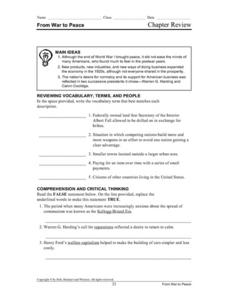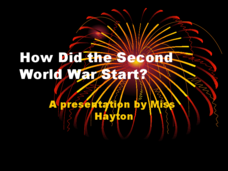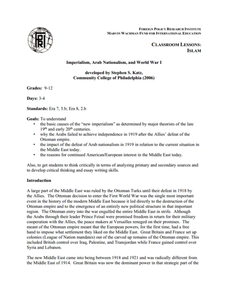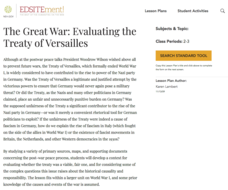Stanford University
League of Nations
An interesting lesson explores the Treaty of Versailles and the creation of the League of Nations to prevent further large scale warfare in World War I. A presentation explains how the United States Congress reacted to the offer to join...
Curated OER
Lesson 3: U.S. Neutrality and the War in Europe, 1939-1940
Students examine the U.S. neutrality policies that preceded American involvement in World War II. In this World War II lesson, students explore the events in Europe from 1939 to 1940 and Roosevelt's decision to give military aid to Britain.
Curated OER
Treaty of Versailles
Students describe the purposes of the Treaty of Versailles. In groups, they analyze the causes and effects of the treaty and discuss why the Americans were so against it. They note ideas for and against its ratification and they make...
Theodore Roosevelt Association
Defining America's Role in the World
As the first American president to win the Nobel Peace Prize, and only one of four presidents to do so in United States history, Theodore Roosevelt's foreign policy achievements and preservation of peace are often overshadowed by his...
Curated OER
From War to Peace
In this post World War I worksheet, learners review a chapter as they write 5 vocabulary terms that match 5 definitions, change 3 false statements into true statements, and explain 2 historical themes regarding this time period in United...
Curated OER
A Series of Intolerable Events
Eighth graders investigate the events that led to World War II. In this Holocaust lesson, 8th graders research primary and secondary sources about the events that led to the war. Students create PowerPoint presentations that provide...
Curated OER
The Rise of Fascism
Young scholars explore the variety of events and the people who would shape Europe during the 1920's, describing how this culminated with the Second World War. They create a timeline of ten pre-war events or people with the corresponding...
Curated OER
Events Leading to World War II in Europe
In this World War II worksheet, students read "Events Leading to World War II in Europe," and then write time lines based on the information presented.
Curated OER
WWI Document Based Essay
High schoolers read various primary source documents on World War I. After reading each document, they answer discussion questions. Using the internet, they identify the causes of World War I as layed out by President Wilson and his...
Curated OER
Treaty of Versailles Vs. MAGIC
In this end of World Wars I and II worksheet, students respond to 6 short answer questions pertaining to the Treaty of Versailles and other peace agreements.
Curated OER
Revisiting the Somme
Students consider how the military folly of the Somme during World War I. In this World War I lesson, students visit selected websites to discover information about the Somme, propaganda, and their effects on the...
Curated OER
How Did WWII Start?
How did the second world war begin? A presentation first looks at the political climate that led to WWI and the effects of that war. Then, it describes the reason Hitler was able to take hold of Germany after WWI and prior to WWII. The...
Maryland Department of Education
The Concept of Identity Lesson 8: Propaganda in Visual Media
Visual and print propaganda are featured in a lesson that asks readers of A Separate Peace to examine the techniques used in propaganda from World War I, World War II, presidential elections, and in the novel.
Foreign Policy Research Institute
Imperialism, Arab Nationalism and World War I
Continued conflict in the Middle East makes this instructional activity relevant, and the inclusion of a critique of Lawrence of Arabia might increase student interest in a potentially challenging topic. The resource includes a...
US Institute of Peace
Perspectives on Peace
Is peace simply the absence of war, or is there more to the story? Young social scientists define peace in the second installment of a 15-part series. Groups work together to explore cultural concepts of peace and the peacemaking process...
Curated OER
World War II: Bombs and Peace
Learners explore the final events and end of World War II. They examine the community impact of such events as the dropping of the dropping of atomic bombs, and President Roosevelt's death. Students prepare a presentation.
Curated OER
Enemy or Ally: America's Response to the Russian Revolution
Students examine the events related to the Russian Revolution. In groups, they use the internet to discover the concerns of Woodrow Wilson during this time period and relate them to the origins of the Cold War. To end the lesson, they...
Curated OER
The Great War: Evaluating the Treaty of Versailles
Young scholars examine and evaluate the Treaty of Versailles. They read and discuss primary source documents, explore various websites, develop a list of postwar goals for France, Germany, and the U.S., and evaluate whether the treaty...
Curated OER
Europe in Upheaval (1850 - 1914)
Europe was in a state of transition and upheaval that spanned a time of 60 years, beginning in 1850 and running through the first World War. Uncover the wars, key players, politics, and social movements that marked this time period in...
Curated OER
Lesson 1: Postwar Disillusionment and the Quest for Peace, 1921-1929
High schoolers examine U.S. foreign policy following World War I. In this foreign policy lesson, students study the Five-Power Treaty and the Kellogg-Briand Pact and their effectiveness in preventing war. High schoolers create political...
Student Handouts
The Cold War: The Truman Doctrine of 1947
What was the Truman administration's position on foreign policy during the Cold War? Class members respond to an excerpt from President Harry S. Truman's "Truman Doctrine" with three questions in the space provided.
Curated OER
The Advantages and Disadvantages of the Treaty of Versailles
Students identify the advantages and disadvantages of the Treaty of Versailles. Using the text of the treaty, they discover it created more tension between groups then bringing peace to the region. They discuss how this treaty could have...
Prestwick House
A Separate Peace
John Knowles' A Separate Peace is the subject of a literary crossword puzzle that asks readers to identify key events and characters in this coming-of-age story.
Curated OER
Introduction to the Early Origins of the Cold War
For this Cold War worksheet, students read a 4-paragraph selection about post World War II diplomacy and then list key dates and events noted in the selection.

























